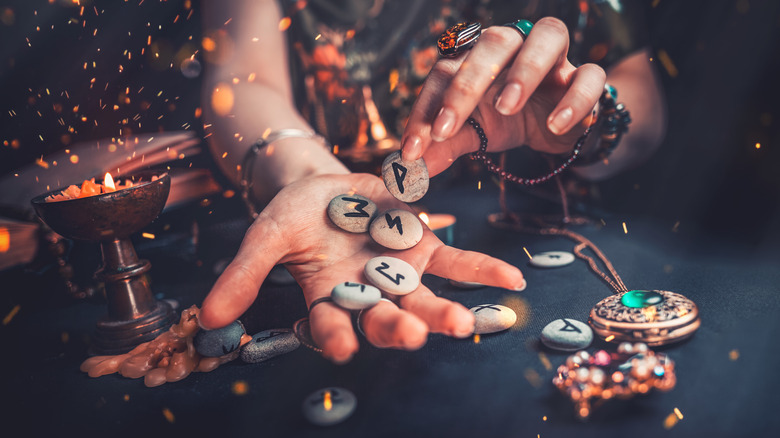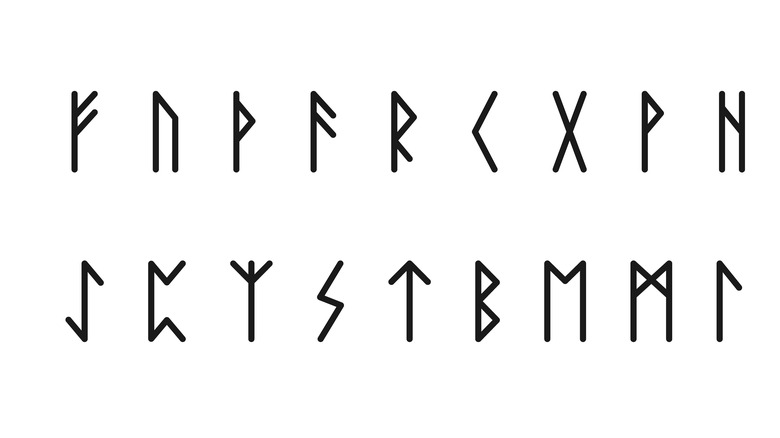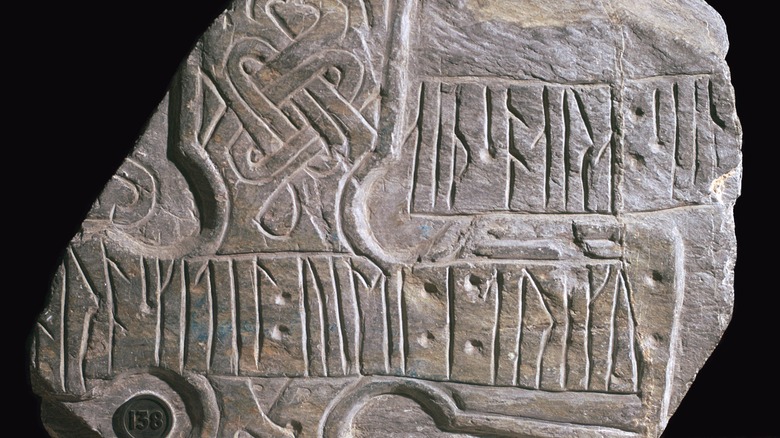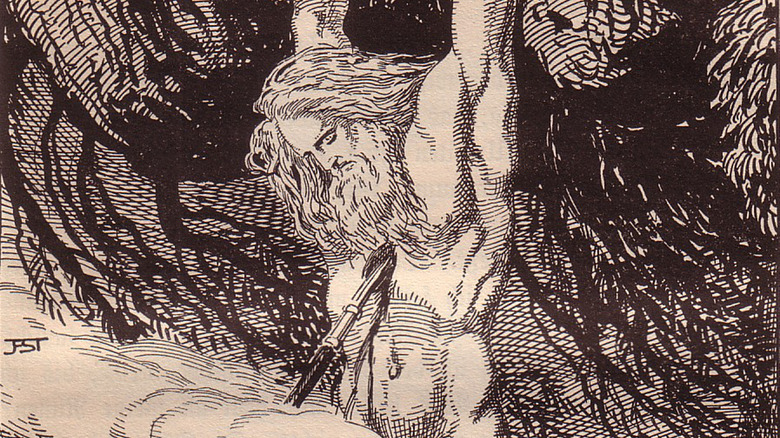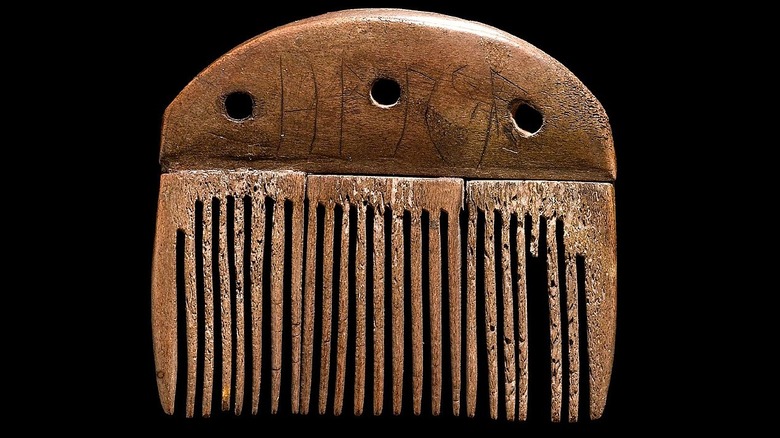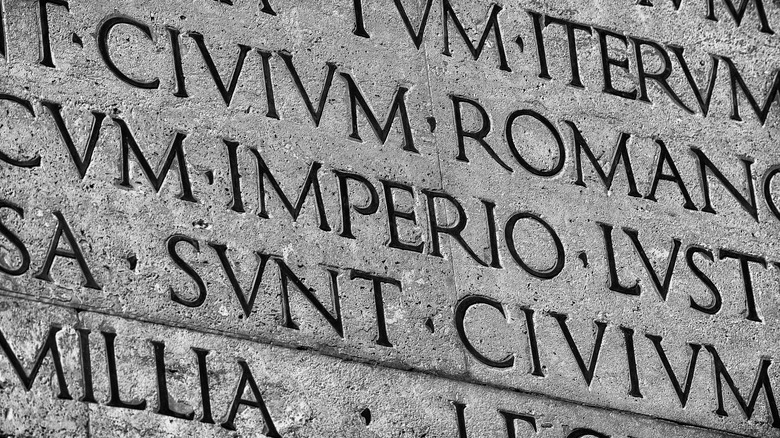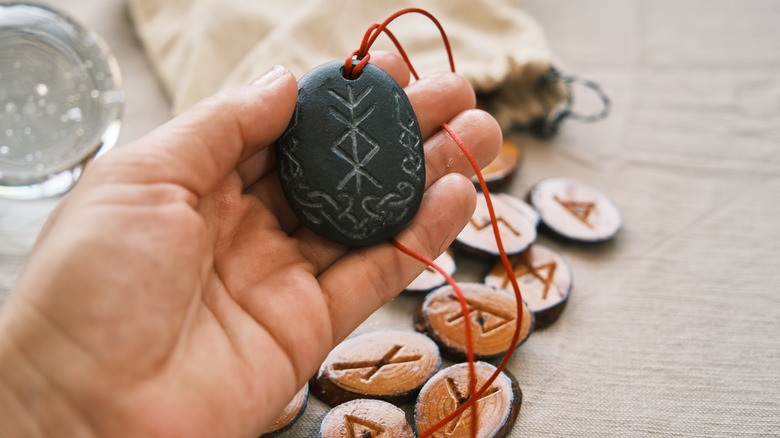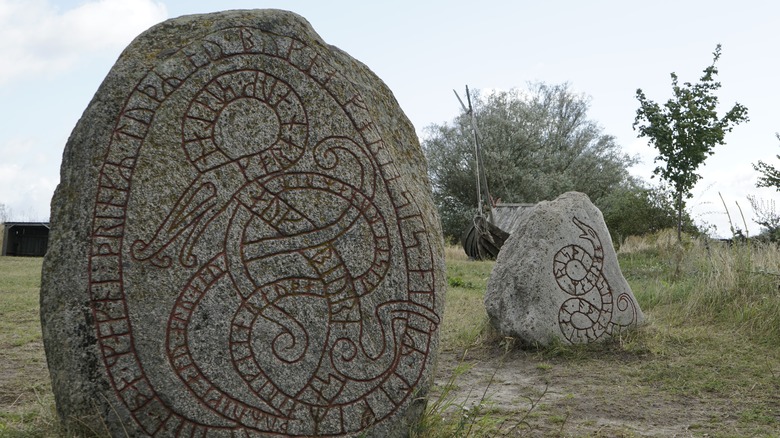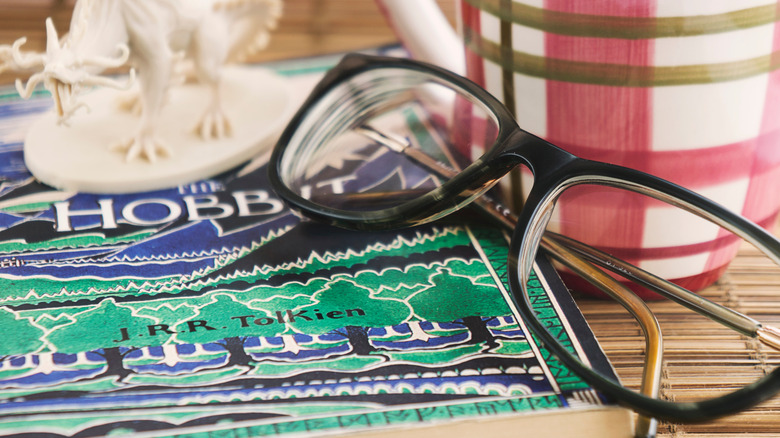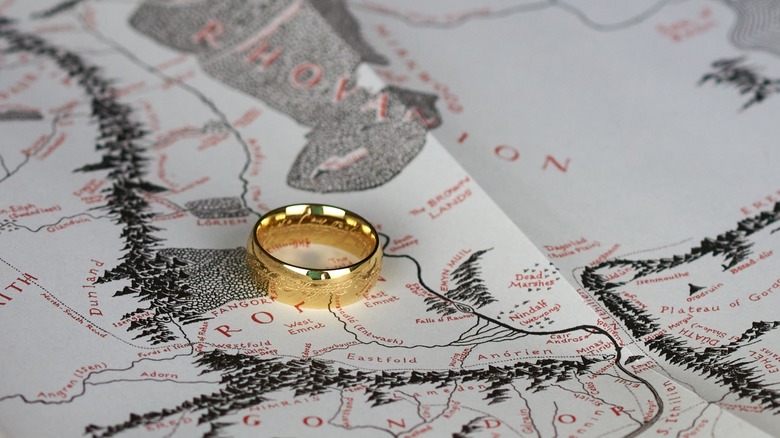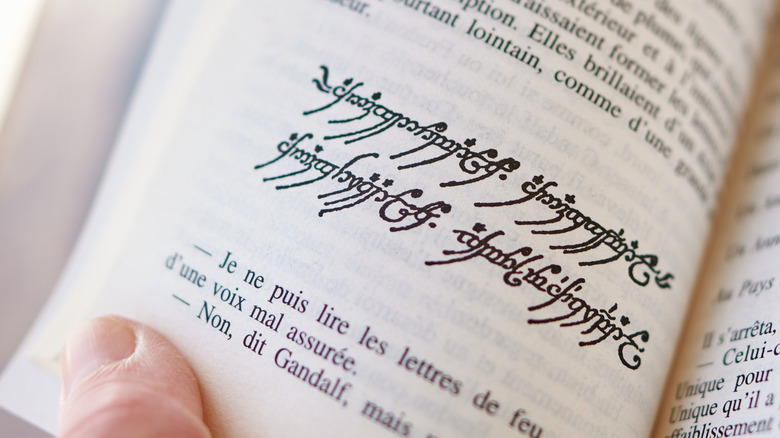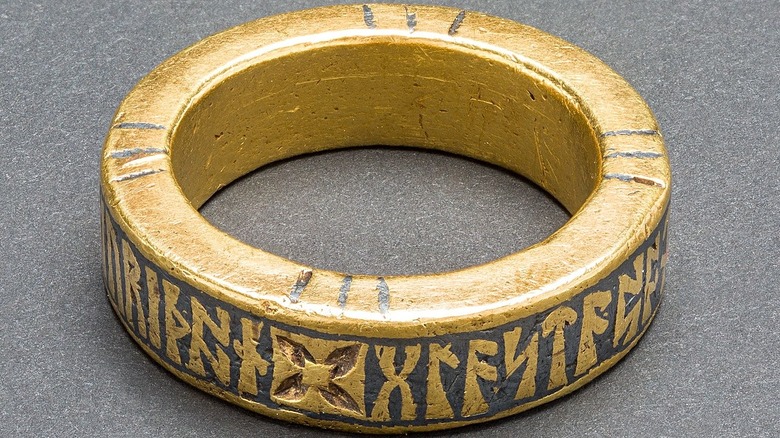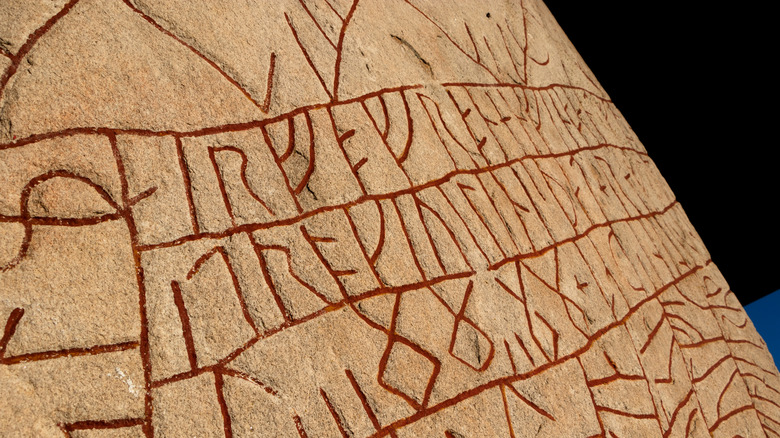Ancient Runes Explained (And How They Influenced The Lord Of The Rings)
Nothing cries out wizardry, witchcraft, dragon-slaying, and magic swords more than ancient runes. These angular characters provide an archaic and mysterious ambience that is more than at home in almost any Advanced Dungeons & Dragons tome worth its ounce of fairy dust. Much of the modern conception of runes can be traced to the work of J.R.R. Tolkien. This author introduced modern readers to his version of ancient runes in "The Hobbit" and then "The Lord of the Rings." In both works, Tolkien uses runes as plot points, setting décor, and challenges to readers. Tolkien did more to spread the word about runes than any medieval academician.
J.R.R. Tolkien was a scholar of Middle and Old English and a master etymologist. He was very keyed-in on how language was transmitted, both in the Latin alphabet and runes. With that said, Tolkien's runes are not real runes but were inspired by the historic versions. This writing system is fascinating in its own right both for its unusual history and its ties to beliefs in magic. Let's look at how ancient runes developed and how they influenced the works of J.R.R. Tolkien.
What are ancient runes?
Runes are simply the letters of a family of alphabets that appeared in northern Europe at least as far back as the second century, according to the World History Encyclopedia. This writing system was used by ancient Germanic and Norse cultures, including the Vikings.
The first thing one notices about runes are their unique, angular appearance. As described by Terje Spurkland in "Norwegian Runes and Runic Inscriptions," runes have a specific structure. Letters consist of a "stave" which is usually a vertical line that runs to the base of the letter. Then there are smaller "twigs" that complete the letter, often on diagonals. So for example, the ᛉ rune consists of one stave and two twigs. The ᛚ rune consists of one stave and one twig, and the ᚷ, of two staves. Sometimes, runes would be combined in what are called "bind-runes." The characters are angular because they were carved letters, rather than being written onto paper with ink.
Just like in a modern alphabet, each rune letter represented a sound. These developed into different alphabets called "Futhark." This name comes from the initial six runes of the alphabet: f, u, th, a, r, k. (One can imagine a Viking toddler learning their f-u-th's in lieu of their a-b-c's.) Runes also had meanings. For example, in one version of runic script, the ᛖ rune, called "ehwaz," not only represented the "e" sound but also meant "horse." In Younger Futhark, the ᚠ rune was the "f" sound but also meant "wealth" or "cattle." The ᚦ rune, which was the "th" sound, meant "giants."
Not all runes are the same
Runic scripts evolved through their history. The World History Encyclopedia reports that the earliest runic alphabet is Elder Futhark, which was used until about A.D. 700. It was a 24-character script that saw widespread usage in northern Europe. It was used to write various early iterations of English, Norse, and German. To date, archaeologists have found roughly 400 different inscriptions using this runic alphabet.
After A.D. 700, Elder Futhark was supplanted by a variant called Younger Futhark. This script had 16 characters, of which some were simplified versions of their Elder Futhark counterparts while others changed shape entirely. Some individual runes could be pronounced in multiple ways, which has made it more difficult for modern scholars to understand. (Runes are also challenging to read because spaces were often omitted between words.) Else Roesdahl's "The Vikings" explains that there were variations of Younger Futhark, with some regions using "long branch" scripts while others opted for "short twig" variations. Still, there are more artifacts of Younger Futhark than Elder Futhark, with there being nearly 3,000 different items bearing the runic script.
Another runic writing system is the Anglo-Saxon Futhorc. This variation developed in Britain and today's Netherlands. Unlike Younger Futhark, which dropped characters, the Anglo-Saxon Futhorc added runes, perhaps as many as eight. These were used until about the end of the 10th century. Then there was a fourth script called Medieval Futhark, which was an adaptation of the Younger Futhark and was used until about the 1200s.
Were runes a gift of the All Father?
J.R.R. Tolkien aficionados would tell you that in Middle Earth, runes are magical. This probably comes from the traditional origin story of Norse runes. According to Norse mythology, the god Odin was a great seeker of knowledge. He had, in fact, sacrificed an eye in order to drink from Mimir's Well, which purportedly contained the waters of wisdom.
Not satisfied with just losing an eye, Odin decided he needed more wisdom. So he hung himself on Yggdrasil, the World Tree, for nine days and nights. During his ordeal, Odin discovered the runes in the waters of the Well of Urd. The Norse saga the "Havamal" recounts Odin telling the story: "...I hung on that windy Tree nine whole days and nights, stabbed with a spear, offered to Odin, myself to mine own self given, high on that Tree of which none hath heard from what roots it rises to heaven. None refreshed me ever with food or drink, I peered right down in the deep; crying aloud I lifted the Runes then back I fell from thence."
By this action, Odin was a sacrifice of himself to himself. He thus became the master of the runes and as a god became closely associated with them. So in Norse mythology, humans didn't create runes; they were a gift from Odin.
Runes originated in northern Europe
According to the World History Encyclopedia, runes were used at least as far back as A.D. 160 when they were used on the Vimose comb, an artifact found in Denmark. Sometimes this comb is also called the "harja comb," which is the transliteration of the runes inscribed on it, which could mean either "comb" or "warrior." Based on these choices of translations, it seems that runic scholars still have a long way to go in understanding the script. Another early runic artifact is a spearhead found in Norway that dates to about the same time, according to Tineke Looijenga's "Texts & Contexts of the Oldest Runic Inscriptions."
It is unknown where runes were first developed. One school of thought places their origins in Scandinavia, in Denmark, Norway, or Sweden. This is based on the fact that almost all runic artifacts have been found in those geographical areas.
However, just because an artifact was found in a region doesn't mean that it originated there. Other evidence suggests that runes may have been developed farther south, in Poland or northwest Germany. Since runes have been traced to several locations, it is more likely that they were not created in a vacuum, but were at least partially shaped by other written scripts.
[Featured image by Nationalmuseet via Wikimedia Commons | Cropped and scaled | CC BY-SA 2.5]
They were influenced by other writing systems
Despite being a compelling tale, scholars have rejected the mystical genesis of runes and ascribe a more mundane origin: cultural diffusion. A glance at the runic alphabet shows that there are similarities in shape and structure to Latin and Greek scripts, while another theory credits the Etruscan alphabet with influencing the development of runes.
According to "The Nordic Languages," one debate is over which script was more influential, Greek or Latin. Those supporting Latin contend that ancient Imperial Roman capital letters directly influenced the creation of runes. The reasoning is that as Rome was militarily abutting and in conflict with ancient Germany, exposure to the alphabet influenced the development of runes among the Germanic peoples. Scholars cite the similar looks of runes to several Latin letters such as M, D, and P, which probably influenced the development of runic script. Per R.W.V. Elliott's "Runes: An Introduction," others note that the Greek alphabet seems more influential. It is likely that both writing systems influenced the development of runes.
Runes were used in magic (seriously)
The people who used runes believed in their mythical origins. This led them to use runes in traditional magic. In PBS's assessment, rune masters were those who were experts in the magical properties of runes and likely held high social status. Runes were used as inscriptions on artifacts that could heal, harm, or protect individuals. This type of magic clearly influenced "The Lord of the Rings." When the Fellowship leaves Lothlorien, the elven queen Galadriel gives the hero Aragorn a scabbard for his ancient sword, Anduril. On the gift are set gems laid out in runes which spell the name of the blade and its lineage.
Rune masters also used runes in divination. One typical method was that, upon being asked a question by a supplicant, a rune master carved runes into shards of bark, which were then thrown upon the ground. The rune master randomly picked three pieces and used the symbols carved into them to answer the question. Likewise, runes could be etched onto pebbles to be placed in a bag, mixed, and dumped out. The answer would be taken from whichever stones landed face-up. Edred Thorsson's book "Futhark" explains that in the original Germanic and Norse languages, the words "rún" and "rúna" translated to "mystery" or "secret."
They were used as memorials
Runes were for carving — not for ink on paper. Therefore, they were carved into many different items, from bones to wood to rock. Most prominent of all the runic artifacts are the large rune stones. There are over 6,000 of them in existence, and most are granite. The Milwaukee Public Museum lists three purposes of these stones. First, some were used as monuments to the dead and contained information about the deceased. Second, some stones were used as forms of self-aggrandizement, boasting about the achievements of the stone erector. Third, stones had religious importance. This was particularly the case by the late 10th century when Scandinavia was being Christianized. Some converts inserted Christian crosses in the runes to tout the new religion. For example, one translation of Denmark's Great Jelling Runestone states, "Harald the King executes these sepulchral monuments after Gorm his father, and after Thrya his mother, the Harald who won the whole of Denmark and all of Norway and turned the Danes to Christianity."
This is not to say that paganism was not represented in runic artifacts. Polytheistic holdouts would defiantly insert pagan symbols among the runes.
Tolkien's script had many more runes
J.R.R. Tolkien used runes from the get-go, incorporating them into "The Lord of the Rings" prequel, "The Hobbit." Tolkien created his own runic alphabet, which he dubbed the "cirth." In his legendarium, the cirth were the invention of the elves of Middle Earth. Like historic runes, Tolkien's fictional cirth were carved into wood or stone. This was opposed to other, cursive scripts which Tolkien had devised. The author was so committed to making his own runic system as realistic as possible, he created different variants, as explained by the "J.R.R. Tolkien Encyclopedia." For example, different cirth scripts were created by elves and dwarves. He even had variants within these different fantasy races, with the dwarves of Moria having one script and the dwarves of the Lonely Mountain having their own version.
While many of Tolkien's runes look exactly like their Germanic counterparts, "The Keys to Middle Earth" by Stuart D. Lee and Elizabeth Solopova points out that the phonetics are different. Tolkien approached his runes in a more organized fashion, grouping certain runes together based on pronounced sounds. Meaningfully, Tolkien's runes impart an air of antiquity to his world. As Stephen Webb describes in "Clash of Symbols," most people who see a rune today will consider it an ancient thing and something to puzzle over. This same sense of age is then transferred by readers to their own impressions of Middle Earth.
Tolkien's use of runes shifted from functional to decorative
The first appearance of runes in J.R.R. Tolkien's works is in "The Hobbit," where they appear on the covers of some editions of the book. Runes played an important part in the story, which centers on the dwarves' quest to regain their treasure from the dragon Smaug in their ancient home in the Lonely Mountain. As part of the quest, the dwarf Thorin Oakenshield is given a special map. This map is then shown to be magical by the lore master Elrond who sees that certain runes appear only under moonlight. This then gives the adventurers the clue as to how they can get into the Lonely Mountain. But the dwarf runes shown in the illustrations in "The Hobbit" are representations of English runes, meaning that the actual dwarf runes in Tolkien's imagination could not be known by the reader.
In "The Lord of the Rings," runes are not as central to the plot. Nevertheless, they are still present, both for aesthetics and in relation to certain plot points. For example, in one scene, the protagonists find a stone carved with a rune which signified the passing of the wizard Gandalf. Then, in the poem, "Song of Earendil" found in "The Fellowship of the Ring," there is this verse about the hero: "In panoply of ancient kings, In chained rings he armoured him; His shining shield was scored with runes to ward all wounds and harm from him."
They were used as riddles by Tolkien
Perhaps the greatest delight to J.R.R. Tolkien and to his readers was the use of runes in his works as intellectual riddles. Tolkien certainly loved riddles, as he demonstrated in the scene where Gollum and Bilbo quiz each other in "The Hobbit." In the same way, Tolkien offered readers a chance to explore the riddle of runes by allowing them to translate the enigmatic symbols. The author's note in "The Hobbit" provides explanatory text on how to do it. It was just up to the reader to make the conversion.
In "Studies in Medievalism XXXII," Fugelso Karl points out that Tolkien emphasized runes as a means by which to challenge readers as well as bring in the desired ancient aesthetic. More recently, the trend has been for creators working in the fantasy genre to emphasize the magical properties of runes far beyond what Tolkien offered. For example, if you were to play a fantasy roleplaying game and you found a battle-axe with runes on it, it is assumed to be magical.
A runic-carved ring may have influenced Tolkien
The plot of "The Lord of the Rings" is centered around the One Ring, a magical ring of power. The ring itself was inscribed with script that glowed when heated.
Curiously, J.R.R. Tolkien may have been influenced by an artifact just like his One Ring, although instead of being cursive script, was inscribed with runes. According to the British Museum (via The Kingmoor Parish Council), a gold ring was discovered at in the early 19th century at Greymoor Hill, Kingmoor, by a young man who was repairing some fencing. The ring became known as the Kingmoor Ring. Per "The Book of English Magic" by Philip Carr-Gomm and Richard Heygate, the inscription seems to be magical in nature, providing a charm meant to ward off leprosy and fever through what is supposed to be an incantation of some kind.
The journal Leeds Studies in English reports that this ring is actually one of over two dozen such known rings, some of which are in inscribed in Latin and others, in runes. Some have been deciphered, while others remain a mystery. In all cases, they are inspirational to look at; if you owned one, you probably wouldn't want to go throw it into a volcano.
[Featured image by Arnold Mikkelsen via Wikimedia Commons | Cropped and scaled | CC BY-SA 4.0]
Runes were not religious symbols to Tolkien
J.R.R. Tolkien was a devout Catholic, and as such there is often a question as to why he would insert runes into his works when the characters were often equated with pagan religions. The Tolkien Society provides some insight into this question. As mentioned earlier, runes in of themselves were not religious symbols like a Christian cross, an Islamic crescent, or a Jewish Star of David. Instead, they were written systems which were used by both Christians and polytheists. For example, the Franks casket dating to about A.D. 700 uses runes to embellish a carving of the Christian story of the "Coming of the Magi". Other runes were incorporated into crosses.
Tolkien dealt with runes as a means for his characters to communicate in an antique way. In doing so, because of the nature of his Middle Earth, he incorporated elements of magic into his runes to emphasize their mysterious knowledge and power. In this way, runes matched how they were seen in historic times: symbols conferred that power and were known only to the few.
